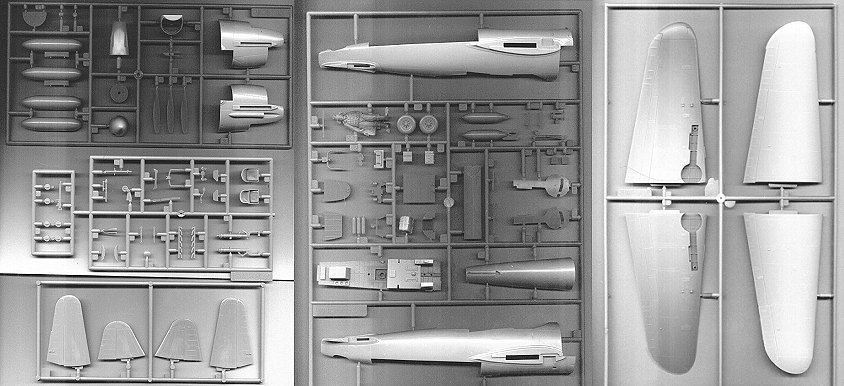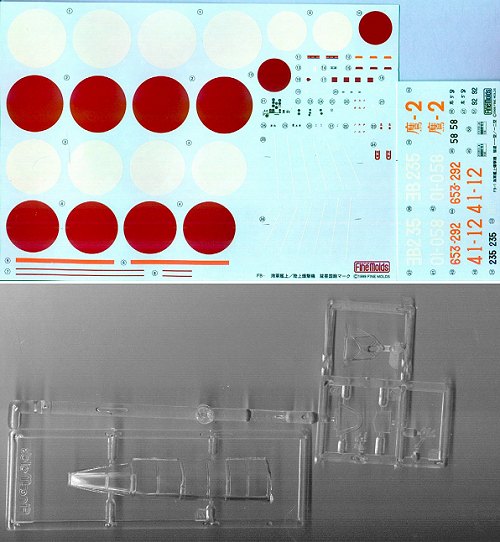
|
KIT: |
Fine Molds 1/48 D4Y1 'Judy |
|
KIT # |
FB 1 |
|
PRICE: |
$26.95 |
|
DECALS: |
See review |
|
REVIEW & |
|
|
NOTES: |
|

|
HISTORY |
The Aichi D3A-1 "Val" good as it was, was already long in the tooth when it participated in the Battles of the Coral Sea and Midway, insofar as developmental concept was concerned. By the summer of 1942 it was clear to the Imperial Navy that the war was not going to be over soon, and that there would be further carrier air battles. A more capable replacement for the Val was needed.
Unfortunately, a very bad choice was mode at the outset as to the powerplant of the airplane, a decision that would hamstring its development and operational use at any time when it might have provided more than a target for the U.S. Navy's Hellcats. The D4Y-1 Judy utilized the Japanese version of the German Daimler Benz DB-601 series engine. As with the Ki-61, the airplane was haunted by the poor production quality of the Japanese production version of this excellent engine. Additionally, the airplane - designed as a two seat carrier attack bomber with a significant bomb load - was underpowered.
The D4Y-1 was never able to completely replace the Val as originally intended. The problem of powerplant led to the development of the D4Y-2 with a Homare radial engine, but this came too late to be of any value to the Japanese, as they had neither the crews nor the carrier decks left to challenge the U.S. Navy in the Pacific War.
The D4Y-1 did get lucky twice: on October 24, 1944, a D4Y-1 managed to slip through the Hellcat fleet defense screen and hit the U.S.S. "Independence," at the time carrying a fully fueled and armed strike force preparatory to launch - a carrier's most vulnerable moment. The resulting fires led to the loss of the ship, the last U.S. Navy fleet carrier to be sunk in combat in the war. On April 13, 1945, another lone Judy caught the U.S.S. "Franklin" at a similar moment, turning the ship into a holocaust of fire. The epic struggle to save the "Franklin," which at the time was a bit more than 100 miles off the coast of Honshu, is a well-known story in the U.S. Navy, an example of damage control and seamanship above and beyond the call of duty.
|
THE KIT |

 Fine Molds was a
company very similar to TriMaster that released several kits of Japanese
subjects in the late 1980s; the kits came with white metal parts and photo-etch
frets for interior details, advanced kit design for the time - and cost around
$60-$80. If you think modelers scream at the price of contemporary Tamiya kits,
the silence surrounding these Fine Molds kits was resounding: in the U.S., the
ones that didn't become shelf-sitters were mostly picked up by collectors. I
only ever remember seeing one of these built up at an IPMS conference, the work
of a super-detailer. Fine Molds has always been associated with Hasegawa; the
kits look similar to Hasegawa kits of the late 1980s, though Hasegawa
representatives have always claimed the two were separate.
Fine Molds was a
company very similar to TriMaster that released several kits of Japanese
subjects in the late 1980s; the kits came with white metal parts and photo-etch
frets for interior details, advanced kit design for the time - and cost around
$60-$80. If you think modelers scream at the price of contemporary Tamiya kits,
the silence surrounding these Fine Molds kits was resounding: in the U.S., the
ones that didn't become shelf-sitters were mostly picked up by collectors. I
only ever remember seeing one of these built up at an IPMS conference, the work
of a super-detailer. Fine Molds has always been associated with Hasegawa; the
kits look similar to Hasegawa kits of the late 1980s, though Hasegawa
representatives have always claimed the two were separate.
Be that as it may, the kits have been re-released recently, minus the white metal parts, and at prices most modelers today would consider quite reasonable. This is not unlike the journey of the contemporaneous TriMaster kits, through DML and now to Italerei.
The Judy is a simple kit, with fine recessed panel lines and good fabric detail. The engine cowling is separate, since the kit originally provided a choice of the inline-powered D4Y-1 or the radial engined D4Y-2. The vertical fin and rudder provide both the early (smaller) and late (larger) production versions. Modelers who have built the earlier kits tell me that the fit of cowling to fuselage is "fiddly," but I suspect anyone capable of dealing with the sometimes fiddly design of Hasegawa kits will have no trouble with this kit.
The kit canopy is clear but thick. Squadron provides a vacuform canopy for the kit, which will go far toward turning the kit into a good-looking model.
Decals are provided for five different D4Y-1s - four early production and one late production aircraft - operated in the Marianas, Philippines and Home Islands during 1943-44. These look similar enough to contemporary Hasegawa that I am sure they come from the same printer, and will likely be as useful as the Hasegawa kit decals are.
|
CONCLUSIONS |
While not as significant an aircraft as its predecessor, the "Judy" was an important aircraft of the IJN during the Pacific War, and as such belongs in any representative collection of the aircraft of the Imperial Navy. Completed, it will look good sitting next to a contemporary Hasegawa Val or Jill.
Thanks to HobbyLink Japan for the review copy.
If you would like your product reviewed fairly and quickly by a site that has over 900 visits a day, please contact me or see other details in the Note to Contributors.